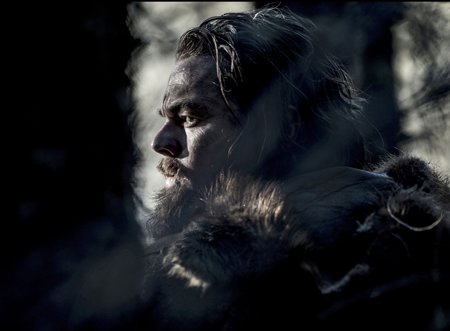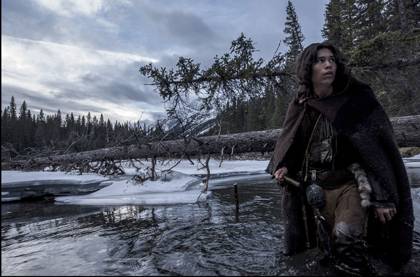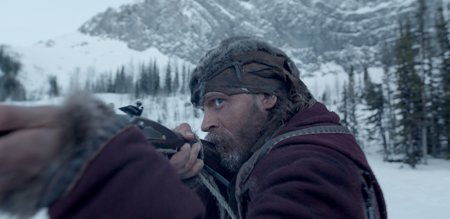Film (2015)
Directed by Alejandro Iñárritu
Screenplay by Mark L. Smith and Alejandro G. Iñárritu
Based in part on the novel by Michael Punke
With Leonardo DiCaprio (Hugh Glass), Tom Hardy (John Fitzgerald), Domhnall Gleeson (Captain Andrew Henry), Will Poulter (Bridger), Forrest Goodluck (Hawk)

in “The Revenant”
Photo: Kimberley French
Copyright © 2015 Twentieth Century Fox Film Corporation
All rights reserved.
This extremely bloody and violent, though remarkably well executed, film traces the life and exploits in Montana and South Dakota of Hugh Glass (1780-1833) an American frontiersman and fur-trapper. Mauled by a grizzly bear, Glass somehow survives and faces a series of other challenges including hostile American Indian tribes and untrustworthy colleagues.
Whereas Quentin Tarantino’s recent The Hateful Eight is equally bloody and grotesque, its dominant tone is satirical. It’s a weird kind of gore-infused satire, but satire nonetheless. As one watches it, one imagines the events as comic-book-like, not very real, and, as a result, grotesquely humorous.
The Revenant is desperately bloody and violent, but it’s effect is just the opposite – truly horrific, vividly realistic and exactingly cathartic. It is not at all satirical and there is no humor in it whatsoever. But it is a beautifully executed biographical epic and justifies, through its consistent artistry, the level of blood and guts that it employs. Though it is hard to watch, none of it seems gratuitous.

in “The Revenant”
Photo: Kimberley French
Copyright © 2015 Twentieth Century Fox Film Corporation
All rights reserved.
The cinematography, as well, is beautifully done. Panoramic shots of the Western wilderness fill out the endless scenes of combat and frame the horrors with a sedateness and visual elegance that is striking. For all of the fuss about the 70mm conveyance of The Hateful Eight, The Revenant actually seems to achieve a significantly more compelling level of camera work. Of course, much of that has to do with its outdoor settings, but, nonetheless, the overall effect is more visually sweeping.
The film is long but entirely engrossing throughout. It is full of non-stop suspense but one never regards it as manufactured. The setup of the plot and its situations seems to lead very naturally into the endless series of challenges and climaxes that it depicts.
It is hard to believe that this story is actually based in fact, though presumably it is. The account of Hugh Glass being mauled by a grizzly and left for dead in the wilderness is not fabricated and one marvels at the film’s explicit rendition of this horrific act and its consequences.
As Glass, DiCaprio does an heroic job of communicating the trials and tribulations of a man truly in individual, desperate straits.
Tom Hardy does a creditable job as the unsympathetic Fitzgerald, and Forrest Goodluck is touching as Glass’ half-Native_American son, Hawk.
Domnhall Gleeson, the Irish actor who is beginning to rival Paul Giammati as the actor most likely to appear anywhere and everywhere – he just showed up as one of the bad guys in Star Wars: The Force Awakens (2015) – does a nice job as the noble group commander here.

in “The Revenant”
Photo: Kimberley French
Copyright © 2015 Twentieth Century Fox Film Corporation
All rights reserved.
Oddly there is something analogous in this narrative to that of the recent sci-fi epic, The Martian, which also features a single heroic individual forced back upon his own ingenuity and gumption to survive. Though the settings are very different, the themes are interestingly related.
There are touches of humane interaction between Glass and some of the Pawnee Indians who otherwise are hell-bent on attacking the Caucasian invaders. The implication of those moments are powerful, and in the midst of a story about constant and unrelenting warfare, those moments rising out of the horrific melee, are compelling and significant.
Iñárritu’s recent Birdman (2014) received immense amounts of attention and plaudits for its unique cinematographic innovation, appearing to be shot in a single take, and for its performances. Indeed its performances were very good, but frankly I found the cinematographic approach a bit gimmicky and the story a bit more elusive and problematic than did others. Here, The Revenant, a completely different kind of effort, seems to exhibit cinmetography that is innovative and very well done, but not gimmicky, good performances and a narrative that has no real holes.
Music for the film is compelling and suggestive throughout, working well with the striking cinematography.
The only slight sense of inauthenticity surfaced in listening Domnhall Gleeson’s accent. Gleeson, a very good young Irish actor, provides a good performance here, but his American accent seems more contemporary than one imagines as characteristic of trappers in the early 1800s.
– BADMan
Leave a Reply